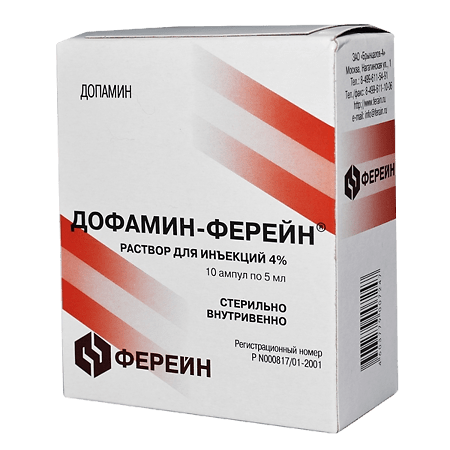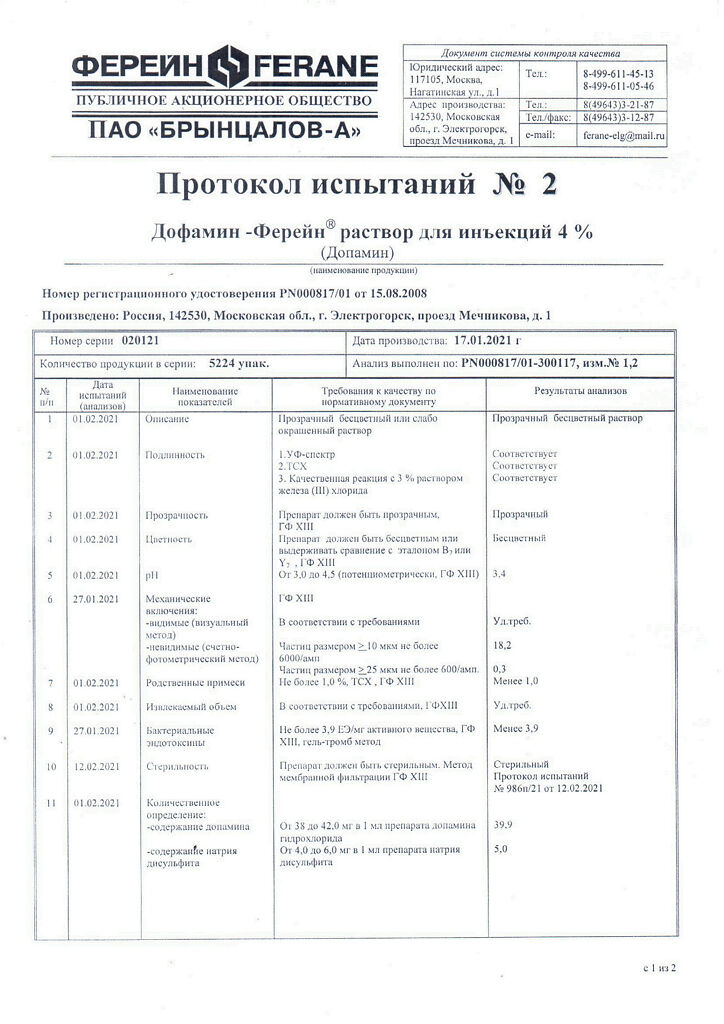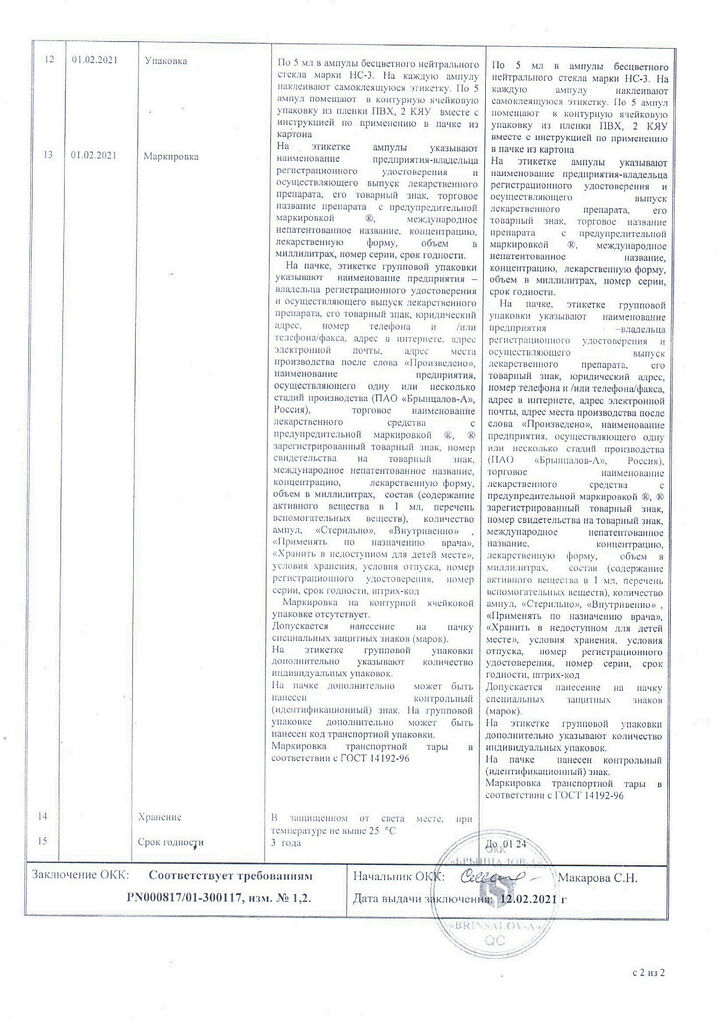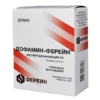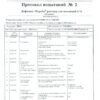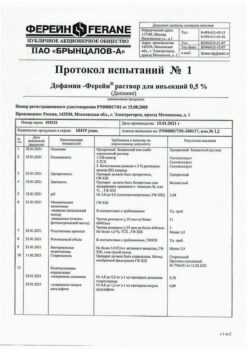No products in the cart.
Dopamine-Ferein, 4% 5 ml 10 pcs
€1.00
Out of stock
(E-mail when Stock is available)
Description
Dopamine is a cardiotonic, hypertensive, vasodilator and diuretic.
It excites beta-adrenoreceptors (in low and medium doses) and alpha-adrenoreceptors (in high doses). Improvement of systemic hemodynamics leads to a diuretic effect. It has a specific stimulatory effect on postsynaptic dopamine receptors in vascular smooth muscle and the kidneys.
In low doses (0.5-3 µg/kg/min), it acts primarily on dopamine receptors, causing dilation of renal, mesenteric, coronary and cerebral vessels. Dilation of renal vessels leads to increased renal blood flow, increased rate of glomerular filtration, increased diuresis and sodium excretion; dilation of mesenteric vessels also occurs (this distinguishes dopamine action on renal and mesenteric vessels from action of other catecholamines).
In low to medium doses (2-10 µg/kg/min), it stimulates postsynaptic beta1-adrenoreceptors, which causes a positive inotropic effect and an increase in the minute blood volume. Systolic blood pressure and pulse pressure may increase; diastolic blood pressure is unchanged or slightly increased. Total peripheral vascular resistance (TPR) is usually unchanged. Coronary blood flow and myocardial oxygen consumption tend to increase. At high doses (10 µg/kg/min or more), alpha1-adrenoreceptor stimulation predominates, causing increased ROS, heart rate, and renal vasoconstriction (the latter may reduce previously increased renal blood flow and diuresis). Both systolic and diastolic blood pressure increase as a consequence of increased minute blood volume and OPPS.
The onset of therapeutic effect is within 5 min against the background of intravenous administration and lasts for 10 min.
Pharmacokinetics
Injected only intravenously. About 25% of the dose is taken up by neurosecretory vesicles, where hydroxylation occurs and norepinephrine is formed. It is widely distributed in the body and partially passes through the blood-brain barrier. The apparent volume of distribution (neonates) is 1.8 l/kg. Binding with blood plasma proteins is 50%.
The drug is rapidly metabolized in the liver, kidneys and blood plasma by monoaminoxidase and catechol-O-methyltransferase to inactive metabolites. Half-life of the preparation (T1/2) – adults: from blood plasma – 2 min, from body – 9 min; newborns – 6.9 min (within 5-11 min).
Extracted by the kidneys; 80% of the dose – as metabolites within 24 hours, in small amounts – unchanged.
Indications
Indications
Shock of various origins, incl. cardiogenic, postoperative, infectious-toxic, anaphylactic, hypovolemic (only after restoration of blood volume), acute cardiovascular failure, low output syndrome in cardiac surgery patients, severe arterial hypotension. Poisoning (to enhance diuresis and accelerate xenobiotic excretion).
Pharmacological effect
Pharmacological effect
Dopamine is a cardiotonic, hypertensive, vasodilator, diuretic.
Stimulates beta-adrenergic receptors (in small and medium doses) and alpha-adrenergic receptors (in large doses). Improving systemic hemodynamics leads to a diuretic effect. It has a specific stimulating effect on postsynaptic dopamine receptors in vascular smooth muscle and kidneys.
In low doses (0.5-3 mcg/kg/min) it acts primarily on dopamine receptors, causing dilation of the renal, mesenteric, coronary and cerebral vessels. Dilatation of renal vessels leads to increased renal blood flow, increased glomerular filtration rate, increased diuresis and sodium excretion; expansion of the mesenteric vessels also occurs (this is why the effect of dopamine on the renal and mesenteric vessels differs from the action of other catecholamines).
In low and medium doses (2-10 mcg/kg/min) it stimulates postsynaptic beta1-adrenergic receptors, which causes a positive inotropic effect and an increase in minute blood volume. Systolic blood pressure and pulse pressure may increase; at the same time, diastolic blood pressure does not change or increases slightly. Total peripheral vascular resistance (TPVR) usually does not change. Coronary blood flow and myocardial oxygen consumption tend to increase. At high doses (10 mcg/kg/min or more), alpha1-adrenergic receptor stimulation predominates, causing an increase in peripheral vascular resistance, heart rate, and renal vasoconstriction (the latter may reduce previously increased renal blood flow and diuresis). Due to an increase in cardiac output and peripheral vascular resistance, both systolic and diastolic blood pressure increases.
The onset of the therapeutic effect is within 5 minutes during intravenous administration and continues for 10 minutes.
Pharmacokinetics
It is administered intravenously only. About 25% of the dose is captured by neurosecretory vesicles, where hydroxylation occurs and norepinephrine is formed. Widely distributed in the body, partially passes through the blood-brain barrier. Apparent volume of distribution (newborns) – 1.8 l/kg. Communication with blood plasma proteins – 50%.
Rapidly metabolized in the liver, kidneys and blood plasma by monoamine oxidase and catechol-O-methyltransferase to inactive metabolites. Half-life of the drug (T1/2) – adults: from blood plasma – 2 minutes, from the body – 9 minutes; newborns – 6.9 minutes (range 5-11 minutes).
Excreted by the kidneys; 80% of the dose – in the form of metabolites within 24 hours, in small quantities – unchanged.
Active ingredient
Active ingredient
Dopamine
Composition
Composition
Active ingredient:
dopamine hydrochloride;
Excipients:
sodium disulfite;
hydrochloric acid 0.1M to pH 3.5-5.0,
water d/i
Contraindications
Contraindications
Hypersensitivity, hypertrophic obstructive cardiomyopathy, pheochromocytoma, ventricular fibrillation.
Side Effects
Side Effects
From the nervous system and sensory organs: headache, anxiety, motor restlessness, tremor of the fingers.
From the cardiovascular system and blood (hematopoiesis, hemostasis): angina pectoris, tachycardia or bradycardia, palpitations, chest pain, increased or decreased blood pressure, conduction disturbances, expansion of the QRS complex, vasospasm, increased end-diastolic pressure in the left ventricle; when used in high doses – ventricular or supraventricular arrhythmia.
From the gastrointestinal tract: nausea, vomiting.
Allergic reactions: in patients with bronchial asthma – bronchospasm, shock.
Other: shortness of breath, azotemia, piloarrection; rarely – polyuria (when administered in low doses); local reactions: if the drug gets under the skin – necrosis of the skin, subcutaneous tissue.
Interaction
Interaction
Pharmaceutically incompatible with alkaline solutions (inactivate dopamine), oxidizing agents, iron salts, thiamine (promotes the destruction of vitamin B1).
The sympathomimetic effect is enhanced by adrenergic stimulants, monoamine oxidase inhibitors (including furazolidone, procarbazine, selegiline), guanethidine (increased duration and enhanced cardiac stimulating and pressor effects); diuretic – diuretics; cardiotoxic effect – inhaled drugs for general anesthesia, hydrocarbon derivatives – such as cyclopropane, chloroform, enflurane, halothane, isoflurane, methoxyflurane (increased risk of severe atrial or ventricular arrhythmias), tricyclic antidepressants including maprotiline (risk of developing cardiac arrhythmias, severe hypertension or hyperpyrexia), cocaine, others sympathomimetics; weaken – butyrophenones and beta-blockers (propranolol).
Weakens the hypotensive effect of guanadrel, guanethidine, mecamylamine, methyldopa, rauwolfia alkaloids (the latter prolong the effect of dopamine).
When used simultaneously with levodopa, there is an increase in the likelihood of developing arrhythmias; with thyroid hormones – it is possible to enhance the effect of both dopamine and thyroid hormones.
Ergometrine, ergotamine, methylergometrine, oxytocin increase the vasoconstrictor effect and the risk of ischemia and gangrene, as well as severe arterial hypertension, including intracranial hemorrhage.
Phenytoin may contribute to the development of arterial hypotension and bradycardia (depending on the dose and rate of administration); ergot alkaloids – narrowing of blood vessels and the development of gangrene.
Compatible with cardiac glycosides (possible increased risk of cardiac arrhythmias, additive inotropic effect, ECG monitoring required).
Reduces the antianginal effect of nitrates, which in turn can reduce the pressor effect of sympathomimetics and increase the risk of arterial hypotension (simultaneous use is allowed depending on the achievement of the required therapeutic effect.
Overdose
Overdose
Symptoms: excessive increase in blood pressure, spasm of peripheral arteries, tachycardia, ventricular extrasystole, angina pectoris, dyspnea, headache, psychomotor agitation.
Treatment: due to the rapid elimination of dopamine from the body, these phenomena are stopped by reducing the dose or stopping the administration; if ineffective, short-acting alpha-blockers (for excessive increases in blood pressure) and beta-blockers (for heart rhythm disturbances)
Storage conditions
Storage conditions
In a place protected from light.
Shelf life
Shelf life
2 years
Manufacturer
Manufacturer
Bryntsalov-A CJSC, Russia
Additional information
| Shelf life | 2 years |
|---|---|
| Conditions of storage | In a place protected from light. |
| Manufacturer | Bryntsalov-A PJSC, Russia |
| Medication form | solution for injection |
| Brand | Bryntsalov-A PJSC |
Other forms…
Related products
Buy Dopamine-Ferein, 4% 5 ml 10 pcs with delivery to USA, UK, Europe and over 120 other countries.

